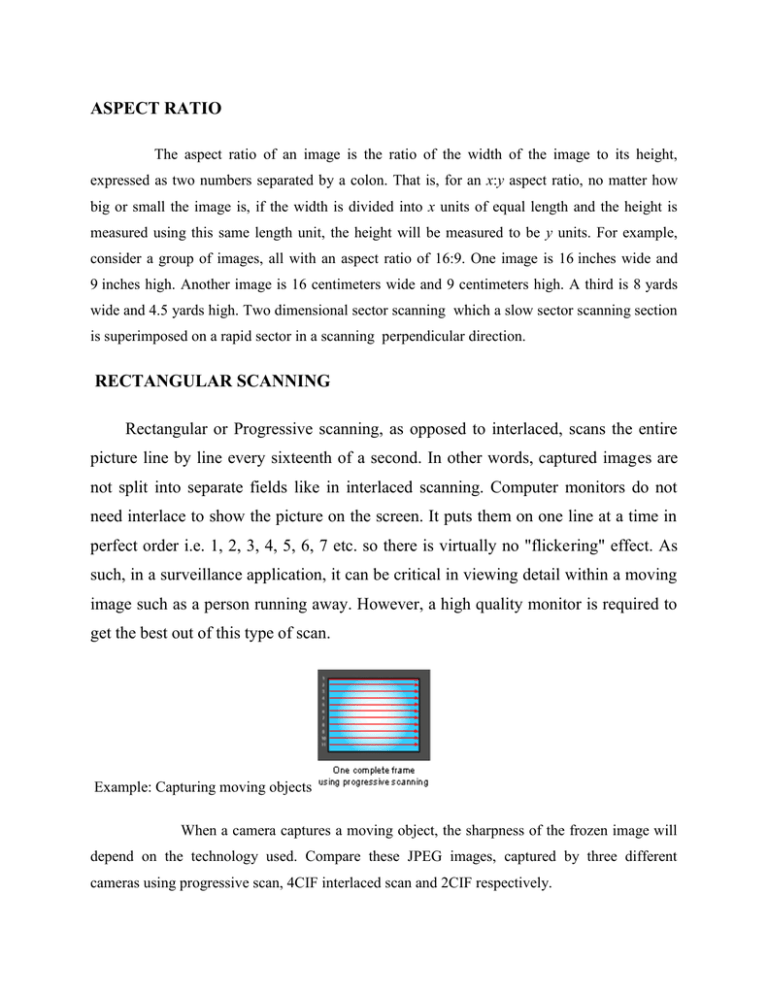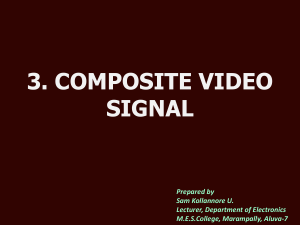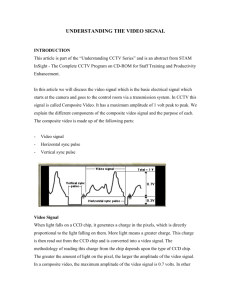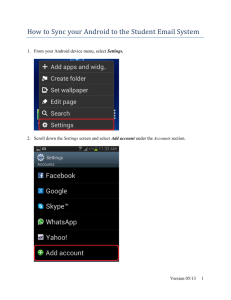Horizontal Blanking Period
advertisement

ASPECT RATIO The aspect ratio of an image is the ratio of the width of the image to its height, expressed as two numbers separated by a colon. That is, for an x:y aspect ratio, no matter how big or small the image is, if the width is divided into x units of equal length and the height is measured using this same length unit, the height will be measured to be y units. For example, consider a group of images, all with an aspect ratio of 16:9. One image is 16 inches wide and 9 inches high. Another image is 16 centimeters wide and 9 centimeters high. A third is 8 yards wide and 4.5 yards high. Two dimensional sector scanning which a slow sector scanning section is superimposed on a rapid sector in a scanning perpendicular direction. RECTANGULAR SCANNING Rectangular or Progressive scanning, as opposed to interlaced, scans the entire picture line by line every sixteenth of a second. In other words, captured images are not split into separate fields like in interlaced scanning. Computer monitors do not need interlace to show the picture on the screen. It puts them on one line at a time in perfect order i.e. 1, 2, 3, 4, 5, 6, 7 etc. so there is virtually no "flickering" effect. As such, in a surveillance application, it can be critical in viewing detail within a moving image such as a person running away. However, a high quality monitor is required to get the best out of this type of scan. Example: Capturing moving objects When a camera captures a moving object, the sharpness of the frozen image will depend on the technology used. Compare these JPEG images, captured by three different cameras using progressive scan, 4CIF interlaced scan and 2CIF respectively. PERSISTENCE OF VISION AND FLICKER The rate of 24 pictures/sec in motion pictures and scanning of 25 frames/sec in TV pictures is enough to cause image continuity. They are not enough to allow brightness of 1 frame to blend smoothly into next through the time, when the screen is blanked between suceesive frames. This results in FLICKER of light that is annoying to observer when the screen is made alternately bright and dark. This problem is solved in motion pictures by showing a picture twice, so 48 views of scene are shown per second. Although the same 24 pictures frame per second. KELL FACTOR The Kell factor, named after RCA engineer Raymond D. Kell, is a parameter used to limit the bandwidth of a sampled image signal to avoid the appearance of beat frequency patterns when displaying the image in a discrete display devices, usually taken to be 0.7. The number was first measured in 1934 by Raymond D. Kell and his associates as 0.64 but has suffered several revisions given that it is based on image perception, hence subjective, and is not independent of the type of display. It was later revised to 0.85 but can go higher than 0.9, when fixed pixel scanning (e.g., CCD or CMOS) and fixed pixel displays (e.g., LCD or plasma) are used, or as low as 0.7 for electron gun scanning. From a different perspective, the Kell factor defines the effective resolution of a discrete display device since the full resolution cannot be used without viewing experience degradation. The actual sampled resolution will depend on the spot size and intensity distribution. For electron gun scanning systems, the spot usually has a Gaussian intensity distribution. For CCDs, the distribution is somewhat rectangular, and is also affected by the sampling grid and inter-pixel spacing. Kell factor is sometimes incorrectly stated to exist to account for the effects of interlacing. Interlacing itself does not affect Kell factor, but because interlaced video must be low-pass filtered (i.e., blurred) in the vertical dimension to avoid spatio-temporal aliasing (i.e., flickering effects), the Kell factor of interlaced video is said to be about 70% that of progressive video with the same scan line resolution. VERTICAL AND HORIZONTAL RESOLUTION The "vertical resolution" of NTSC TV refers to the total number of lines (rows) scanned from left to right across the screen - BUT Counted from Top to Bottom, or Vertically. This number is set by the NTSC TV 'Standard' .This Vertical Resolution number is static - it doesn't change. Therefore, the Vertical Resolution is the same for ALL TV's manufactured to meet a specified Standard. The horizontal resolution of television, and other video displays, is dependent upon the quality of the video signal's source. As an example - the horizontal resolution of VHS tape is (about) 240 lines; broadcast TV (about) 330 lines, laserdisc (about) 420 lines; and DVD (about) 480 lines. To avoid getting entangled too deeply within the inherent complexities of TV technology, it's sufficient to note that there are a number of variables contributing to the 'stated' horizontal resolution value. Even the measurement methods are not always consistent. For instance - how the vertical columns (dots/dashes) are counted ... as single black / white (dark and light) lines, or as "line pairs - (1) black and (1) white line." A TV's resolution can be reported as the result of counting the total number of picture elements (pixels) per scan line, across the entire screen-width, multiplied by the total number of scan lines. However, TV screen-sizes vary, making an equal comparison of different displays more complex. TV's also differ technically, functionally and in component quality; this results in additional complications. An alternative method is to count the number of pixels that fit within a prescribed circle, having a diameter equal to the screen height. Known as LPH - Lines per Picture Height - this is the 'correct' method in determining TV resolution. As this shows, along with other, similar variables, the accuracy of a 'stated' horizontal resolution for a particular display, may depend on who is doing the 'stating' . However, for the purpose of this overview of HDTV-Resolution, the primary point regarding horizontal resolution, is that it is variable. Unlike vertical resolution which is 'fixed,' horizontal resolution can differ from one TV display to another. VIDEO BANDWIDTH BWS = 1/2 [(K × AR × (VLT)² × FR) × (KH / KV)] Where: BWS = Total signal bandwidth K = Kell factor AR = Aspect ratio (the width of the display divided by the height of the display) VLT = Total number of vertical scan lines FR = Frame rate or refresh rate KH = Ratio of total horizontal pixels to active pixels KV = Ratio of total vertical lines to active lines The circuits that process video signals need to have more bandwidth than the actual bandwidth of the processed signal to minimize the degradation of the signal and the resulting loss in picture quality. The amount the circuit bandwidth needs to exceed the highest frequency in the signal is a function of the quality desired. To calculate this, we assume a singlepole response and use the following equation: H(f)(dB) = 20log(1/(1+(BWS/BW-3dB)²).5) Rearranging and solving for the -0.1dB and the -0.5dB attenuation points, we get the following: BW-3dB min = BWS (-0.1db) × 6.55 BW-3dB-min = BWS(-0.5db) × 2.86 Where: BW-3dB = the minimum -3db bandwidth required for the circuit A minimum bandwidth that's about six and a half times' the highest frequency in the signal. If you can tolerate 0.5dB attenuation, it needs to be only about three times. To account for normal variations in the bandwidth of integrated circuits, it is recommended that the results from equations 3 and 4 be multiplied by a factor of 1.5. This will ensure that the attenuation performance is met over worst-case conditions. In equation mode, it is expressed as follows: BW-3dB nominal = BW-3dB-min × 1.5 In addition to bandwidth, the circuits must slew fast enough to faithfully reproduce the video signal. The equation for the minimum slew rate is as follows: SRMIN = 2 × pi × BWS × Vpeak Substituting and simplifying, SRMIN = BWS × 6.386 This is because some distortion can occur as the frequency of the signal approaches the slew-rate limit. This can introduce frequency distortion, which will degrade the picture quality. Multiplying the equation 6 result by a factor of at least two or three will ensure that the distortion is minimized. In equation form: SRnominal = SRMIN × 2 As an example, let's assume we have a standard NTSC video signal and the following requirements: VLT = 525 TVL = 346 AR = 1.3333 KH = 1.17 FR = 29.94 KV = 1.09 Using equation 1, we calculate a maximum signal bandwidth (BWS) of about 4.2MHz. This is the highest frequency in the signal. Now let's assume that we need less than 0.1dB attenuation. Using equation 3, we calculate the minimum signal bandwidth necessary to be 27.5MHz. Using equation 5, to account for variations, gives 41.3MHz. This is the circuit -3dB bandwidth required to achieve our desired resolution and maintain the signal quality. The last calculation we need to make for our example is the minimum slew-rate requirement. Using equations 6 and 7 and plugging in the 4.2MHz value for BWS, we see that we will need at least a slew rate of 52V/μs and a more desirable value of 80V/μs. INTERLACED SCANNING Interlaced scan-based images use techniques developed for Cathode Ray Tube (CRT)based TV monitor displays, made up of 576 visible horizontal lines across a standard TV screen. Interlacing divides these into odd and even lines and then alternately refreshes them at 30 frames per second. The slight delay between odd and even line refreshes creates some distortion or 'jaggedness'. This is because only half the lines keeps up with the moving image while the other half waits to be refreshed. Fig: 1.5 The effects of interlacing can be somewhat compensated for by using de-interlacing. Deinterlacing is the process of converting interlaced video into a non-interlaced form, by eliminating some jaggedness from the video for better viewing. This process is also called line doubling. Some network video products, such as Axis video servers, integrate a de-interlace filter which improves image quality in the highest resolution (4CIF). This feature eliminates the motion blur problems caused by the analog video signal from the analog camera. Interlaced scanning has served the analog camera, television and VHS video world very well for many years, and is still the most suitable for certain applications. However, now that display technology is changing with the advent of Liquid Crystal Display (LCD), Thin Film Transistor (TFT)-based monitors, DVDs and digital cameras, an alternative method of bringing the image to the screen, known as progressive scanning, has been created. COMPOSITE VIDEO SIGNAL Composite video is often designated by the CVBS initialize, meaning "Composite Video, Blanking, and Sync." It is usually in standard formats such as NTsC, pAL, and sECAm. It is a composite of three source signals called Y, U and V (together referred to as YUV) with sync pulses. Y represents the brightness or luminance of the picture and includes synchronizing pulses, so that by itself it could be displayed as a monochrome picture. U and V represent hue and saturation or chrominance; between them they carry the color information. They are first modulated on two orthogonal phases of a color carrier signal to form a signal called the chrominance. Y and UV are then combined. Since Y is a baseband signal and UV has been mixed with a carrier, this addition is equivalent to frequency-division multiplexing. HORIZONTAL AND VERTICAL SYN TV SYNCHRONISATION The sync pulses of a tv waveform need to be able to allow the receiver or monitor to reliably produce an accurate picture. The form of the synchronisation waveforms is described here. The description given here applies to the European 625 line CCIR (or PAL) signals but the arguments can be applied to other interlaced tv systems. Basics A tv picture is built up of a spot scanned rapidly on the faceplate of a crt (cathode ray tube) horizontally and (relatively slowly) vertically to produce a 'raster'. The brightness of the spot is varied to produce the picture. A synchronising signal to control the position of the spot on the screen is combined with the brightness (or luminance) information producing a 'composite' tv signal. The sync and brightness information are kept separate by assigning them unique signal level ranges (see line waveform below). Normally, the total range of a monochrome (black and white) signal is 1 Volt peak-to-peak although the absolute dc levels may vary (usually the signal is ac coupled). The luminance information occupies a range of around 0.7 V and the sync 0.3 V. With respect to the lowest sync level, the brightest parts of the picture are at a level of 1 V with the black level at 0.3 V. Black level is the same as the blanking level in CCIR system (though this isn't necessarily the case for other systems); blanking occurs in non-picture parts of the waveform when it is necessary for the electron gun of the crt to be 'off' so that retrace is not visible on the screen. The tv waveform carries pulses (at sub-black levels) that allow synchronisation of both the horizontal and vertical deflection circuits. These pulses are separated by the video information using a 'sync separator' - this can be just a comparator with its threshold set around halfway between black level and the sync tips. See 'Notes' below for more information on sync separation. There are two deflection generators (timebases) - horizontal and vertical. Both must be triggered at the right time to ensure that the picture is correctly reproduced. Therefore both timebases need to be synchronised and there needs to be a method of triggering either one independently using the same single set of sync pulses. The method used to allow the receiver to distinguish between the two types of sync is to use different widths for the horizontal and vertical sync pulses. Line Sync A single line is shown in the figure below. The sync pulse is separated from the active picture information by the 'porches': the 'back' and 'front' porches. These avoid the picture detail affecting the accuracy of the synchronisation. (A further feature of the back porch is the ability of this otherwise unused period to include a phase reference signal for colour decoding in the PAL and NTSC colour systems). INTERLACE In tv, the same effect (of increasing the refresh rate by a factor of 2) is achieved by the use of interlace, that is, splitting each picture into two fields. A field is a single vertical scan. Each field consists of half the total picture lines (312½) which is scanned from top to bottom of the display at twice the picture rate. The second field then completes the picture by scanning its lines between those of the first field. Thus a complete picture is produced in 1/25th of a second but the effective scan rate is twice this (50 Hz). So a picture containing 625 lines is actually made up of two separate vertical scans, each of 312½ lines. This is termed 2:1 interlace (although as this order of interlace Interlace will reduce the visibility of large area flicker but small detail that isn't common to both fields will show up as 25 Hz flicker. However, this is not obvious to the viewer at normal distances since the eye is unable to perceive rapid variations in time in areas of very fine detail in a picture. Close examination of a blank scanned raster on a monochrome display will enable the 25 Hz flicker to be seen, though it tends to be rather more visible on picture detail such as sharp edges that are at small angles to the horizontal where there can be very large local differences between the two fields. (Close examination of an interlaced picture may also exhibit the phenomenon of 'line crawl'; this effect gives the appearance of all the lines moving up (or down) the screen. Higher orders of interlace are more prone to this which can be distracting at normal viewing distances; this is partly why 2:1 interlace and not higher orders is used.) Fig: The Appearance of a Raster on a CRT (with zero flyback time) FIELD SYNCHRONISATION Broad pulses or serrations are used for triggering the field scan generator. In order to keep the line sync generator running continuously, falling edges appear every 64 microseconds throughout the entire field blanking interval for this purpose. Because there is an effective half line offset between the two sets of field sync pulses it is necessary to double the frequency of the line syncs during the field sync pulses. This allows identical pulse trains to be used for both field syncs. EQUALISATION PULSES The field sync pulses can be distinguished from the line syncs using simple analogue techniques. This was the method universally used until recently when pseudo digital techniques became easier and took over. One method is, having ac coupled the sync pulses (after stripping the picture information), to integrate them; this will result in a drift of level downwards during the field pulses of the integrated waveform, this negative signal can be used to trigger the vertical sync generator. Now, for proper interlace to be achieved it is necessary for the field sync generator to be triggered after identical delays after the last picture line of both odd and even fields. If the field sync pulses occurred immediately following the end of the picture, then there would be a potential difference in triggering times since, at the end of the odd field, there would be only half a line duration following the line sync pulse before the start of the field sync pulses whereas at the end of the even field there would be a full line delay. The equalisation pulses, which are inserted before the field syncs, allow the integrator to settle and be minimally influence by the presence of the line syncs. It is worth noting that the equalisation pulse width is half that of the line sync pulses - this compensates for the doubling in frequency, so that the dc level at the integrator output is unaffected. Further equalisation pulses are inserted after the field syncs to ensure that the trailing edge of the integrated waveform is the same for both fields for those circuits where this may be critical (e.g. where the area under the waveform can influence the triggering point). Fig: Field Sync Waveforms (CCIR 625 line system) The equalisation pulses and the field sync are identical for both fields and are shown in detail below: DESIGNATING LINES AND FIELDS Each line of a complete picture is individually numbered. Lines are always numbered consecutively in time and not as displayed on the crt screen. However, since it is necessary to distinguish between the two fields which go to make up each picture the terms 'odd' and 'even' are used. The 'odd' field is defined as the one which ends in a half-line of picture information; whilst that which ends in a full-line of picture information is termed the 'even' field. Choice of Field Frequency It is easy to see why 25 pictures per second rather than 24 was chosen. The effective vertical scan frequency is 50 Hz and in the early days of tv, mains (at 50 Hz) could break through from imperfectly filtered power supplies. This would manifest itself on the picture by modulating the brightness of the picture or the position of the raster. If there were a difference of 1 Hz (i.e. 25 24 Hz) this modulation would show up very noticeably by rolling up the screen once every second. Using a 50 Hz scan causes the modulation to be stationary on the screen which is far less noticeable. In the US and elsewhere where the mains frequency is 60 Hz the field rate is also 60 Hz. However, choosing a picture rate related to the local mains frequency means that televising cinema films (filmed at 24 frames per second - fps) isn't straightforward. In Europe cinema films are transmitted at 25 fps, this means that the action is marginally increased in speed and the sound raised in frequency by roughly a semitone. This is not normally considered to be a problem. In the US, on the other hand, it would be impractical to show films at 30 fps. But by adding a degree of complexity to the scanning process, they are shown at a film rate of 24 fps and the higher tv rate is accommodated by taking pairs of film frames and spreading them between 5 tv fields. The first film frame takes 2 tv fields and the second film frame, 3 tv fields (i.e. 1½ pictures). The sequence ends after 10 complete tv fields (i.e. 5 pictures) which takes the same time as 4 film frames. Filmed material, destined to be shown on tv only, is very often shot at 25 or 30 fps depending on the intended broadcast system - this does away with speed errors or complications of scanning. 1. SYNC SEPARATORS: Chips that will perform this function (as well as having some other useful features) are the National Semiconductor LM1881 or the (more sophisticated) Elantec (now Intersil) EL4581. 2. SYNC PULSE GENERATORS: The idea of an SPG is that a fixed frequency clock goes in and the correct waveforms come out. Locking to a timebase supplied externally is usually an option (Genlocking). In practice timings (pulse durations) can be a bit off and there may be other quirks. o The first single chip SPG was the Ferranti (later GEC Plessey) ZN134 (16 pin DIL); I mention this as (I believe) it was the first (produced some time in the late seventies). It was able to produce either 625 or 525 line waveforms correctly. Long obsolete. o The RCA (now Intersil) CD22402 is basically a 525 line SPG, it can produce a correct 525 line waveform (which has 6 equalisation and field sync pulse) but produces 6 of each in the 625 mode rather than the correct 5. In practice, this defect is unlikely to be a real problem but it looks like a silly oversight by the designers. Obsolete, but some may still be around. o My favourite sync pulse generator is the Philips SAA1101. This is programmable to provide 625 or 525 line standards (correctly) and signals for PAL, NTSC or SECAM encoding. Interlace can be switched off as well. This device is now a discontinued product but the datasheet is well worth studying for insight into the synchronising waveforms (but note that some of the waveforms in the datasheet haven't been drawn particularly accurately). o The only single chip SPG currently in production that I know of is the Fairchild 74ACT715. This is a wholly programmable device which can produce almost any set of video timing waveforms. It is designed to give NTSC 525 line waveforms by default but while other line system waveforms can be generated it will require some ingenuity to achieve this - registers need to be loaded with the correct numbers every time it is switched on. Fairchild haven't given any application notes, which, had they done, would make the chip possibly more attractive to use in a design. Has anyone any experience of this chip? Let me know. 3. The definition of Odd and Even Fields follows the nomenclature used in Report No. 124 adopted by the International Radio Consultative Committee at its Plenary Assembly in Los Angeles in 1959. Return to text (or press 'Back' button). People who should know better manage to get things quite wrong; see what they say. 4. The timing datum for all the pulses (line sync, field sync and equalisation) is the falling edge. Falling edges are separated by either 32 or 64 microseconds). 5. Equalisation pulses are a desirable feature of a tv waveform. However, many tv systems (as well as home computers and games) can produce adequately interlaced pictures without them. Two such systems were the British 405 and the French 819 line systems. The absence of equalisation pulses may result in a defect called line pairing - its appearance is as described - the lines of the raster are not evenly spaced but appear on the screen with gaps alternating between wide and not-so-wide. Provided that the lines are distinct, however, this impairment is not serious - its main effect is to make the line structure more visible at normal viewing distances. 6. In the UK, some broadcasters, at least sometimes, choose to extend the field blanking by half a line at the end of the odd and the beginning of the even fields thereby extending the field blanking by one line in total. This means that there are no active half picture lines but it also means that the blanking signal is different for the two fields (and therefore harder to produce). Additionally, now that we're all going digital, many programmes in the UK are transmitted with fewer active lines than is specified. This is equivalent to increasing the number of lines blanked. 7. Extra signals are inserted during the field blanking interval and before the 'official' start of the picture (lines 23 or 336). These signals are for in-service network testing using the Insertion Test Signal (ITS) or for teletext transmission. Lines 7 - 22 and 320 - 335 are available for text data although, in practice, not all are usually used. The ITS usually is broadcast on two lines per field: 19, 20, 332 and 333 are used. BLANKING STANDARDS Enables TVs to 'lock on' to signals. Sync signal level is '0v'. Always a small 'quiet' 0.3v 'blank' period around sync pulses (stops old circuitry getting confused). Areas of synchronisation known as 'blanking periods' Originally designed as times where the electron gun in the TV was 'blanked' for the retrace back to the left/top-left of the screen. Two sorts of blanking period: Horizontal blanking period: o Sits between lines of image data. o Contains "start of line" point. o Accurate timing is crucial in getting jiggle-free images. Field blanking period: o Sits between fields of image data. o Tens of scanlines long. o Contains a special sequence of sync pulses. o Contains the 'start of field' point. These periods overlap. (Sync pulses areas in field blanking period take precedence). More details below. The following (probably over-simplified) diagram shows how these blanking periods overlap. In the real signal, the field blanking period covers more scanlines and there are far more scanlines in a frame! Fig: Over-simplified diagram of blanking periods Horizontal Blanking Period Contains the 'start of scanline' sync pulse. The following diagram shows a signal's voltage level over a couple of horizontal blanking periods. Some scanlines with horizontal blanking periods fall within the Field Blanking Period. These scanlines do not carry Picture Data (they can, however, carry other data, such as teletext). Horizontal Blanking Period = Front-Porch + H-Sync pulse + Back-Porch Start of H-Sync signifies start of scanline. Many more details (rise/fall times etc.) left out here. Back-Porch is where colour synchronisation occurs. Back-Porch is empty for monochrome. Timing table: Area Whole Scanline PAL NTSC 64μs 63.55μs Front Porch 1.65μs 1.5μs H-Sync pulse 4.7μs 4.7μs Back Porch 5.7μs 4.5μs Blanking period (total) 12.05μs 10.7μs 'Active Display' period 51.95μs 52.9μs A scanline 'starts' when the H-Sync pulse starts (yes - worth repeating). Timing of H-Sync pulse start is crucial. Jitter on H-Sync pulse = wobbly picture (effect similar to poor video recorders from the 80's). Length of H-Sync pulse less critical. 4μs pulse works nicely. Most microcontroller video output seems to use 4μs H-Sync pulse. Field Blanking Period Hides movement of electron gun trace back Contains 'field start' datum point. Field Blanking Period for Odd and Even fields identical, but... Odd Field Blanking: starts at normal scanline boundary. to top-left of screen. Even Field Blanking: starts halfway through scanline. 3 sections of pulses at start of blanking period: Pre-equalising pulses Vertical Sync pulses Post-equalising pulses. Each section lasts for 5 half-scanlines. (NTSC: 6 half-scanlines). Each Pre/Post-equalising half-scanline: Single short pulse Nothing else. Each Vertical Sync half-scanline Single broad pulse Nothing else. A field's 'start point' is the start of the first broad sync. Duration of PAL / NTSC Short Sync pulse 2.35μs Broad Sync pulse (scanline_duration / 2) - 4.7μs The 'Short Sync' pulse is exactly half the duration of the H-Sync pulse. The following diagram shows the first 15 half-scanlines in the field blanking period. INTER CARRIER SYSTEM Inter carrier as used in TV transmitters In TV transmitters, both AF and VF modulate intermediate frequency (IF) carriers. (The frequency difference between the two carriers is 4.5 MHz. in system M and 5.5 MHz. in system) Then the modulated IF signals are added either at the output of the vision modulator or at the output of the vestigial sideband stage. In both cases, the added signals are low level signals and no special combining circuitry is required. Frequency conversion and amplification is common. So a frequency converter (or a mixer) and a series of amplifiers for aural signal as well as an output combiner are spared, which reduce the cost of the transmitter and electricity consumption of the amplifiers considerably. Although a notch filter to suppress the inter modulation products is used at the output of the inter carrier transmitter, the cost of the notch filter is not comparable to the cost of extra amplifiers and the output combiner. (See the subsection Inter modulation products below) In TV receivers, the received radio frequency signal is converted to IF in tuner and then demodulated. The output of the demodulator consists of a VF and an aural signal which is in fact an FM subcarrier modulated by AF. (The subcarrier is 5.5 MHz. in system B and 4.5 MHz. in system M ) The aural signal and the VF are separated by a simple filter. The only extra stage needed for AF (other than the loudspeaker) is an FM demodulator.[1] The inter carrier receiver system makes for easier tuning of a TV station. The viewer could fine tune such a set to get the best picture reception, and not lose sound reception. (Although AF VF signals are combined in the IF stages of the transmitters, they are separated in baseband stages of the receivers.) When VF and the aural signal modulate the same carrier the inevitable non-linearity of the electronic circuits cause unwanted signals which are called inter modulation products. The unwanted signals appear on RF spectrum at regular intervals, the interval being equal to the frequency difference of the visual and aural carriers. In TV broadcasting the inter modulation products of the aural subcarrier and the main carrier appear out of the RF band of the TV channel. However, out of band product means an unwanted transmission in the neighbour TV channels. For example, inter modulation products of channel 7 appear in channel 5,6, 8 and 9. That is why notch filters are used in inter carrier system. STANDARD CHANNEL CHARACTERISTICS In CCIR system B standards for TV channel USB is fully transmitted while LSB is passed upto 0.75 MHZ The end slopes are allowed as 0.5MHZ as LSB is suppressed fully at 1.25 MHZ while USB is fully attenuated The sound carrier with frequency modulation carrier deviation upto + or -50KHZ is positioned at extremity of side band at 5.5 MHZ. This is logical; placed to minimize interference between sound and picture signals Therefore channel width=7 MHZ, from -1.25 MHZ to +5.75MHZ bandwidth.





